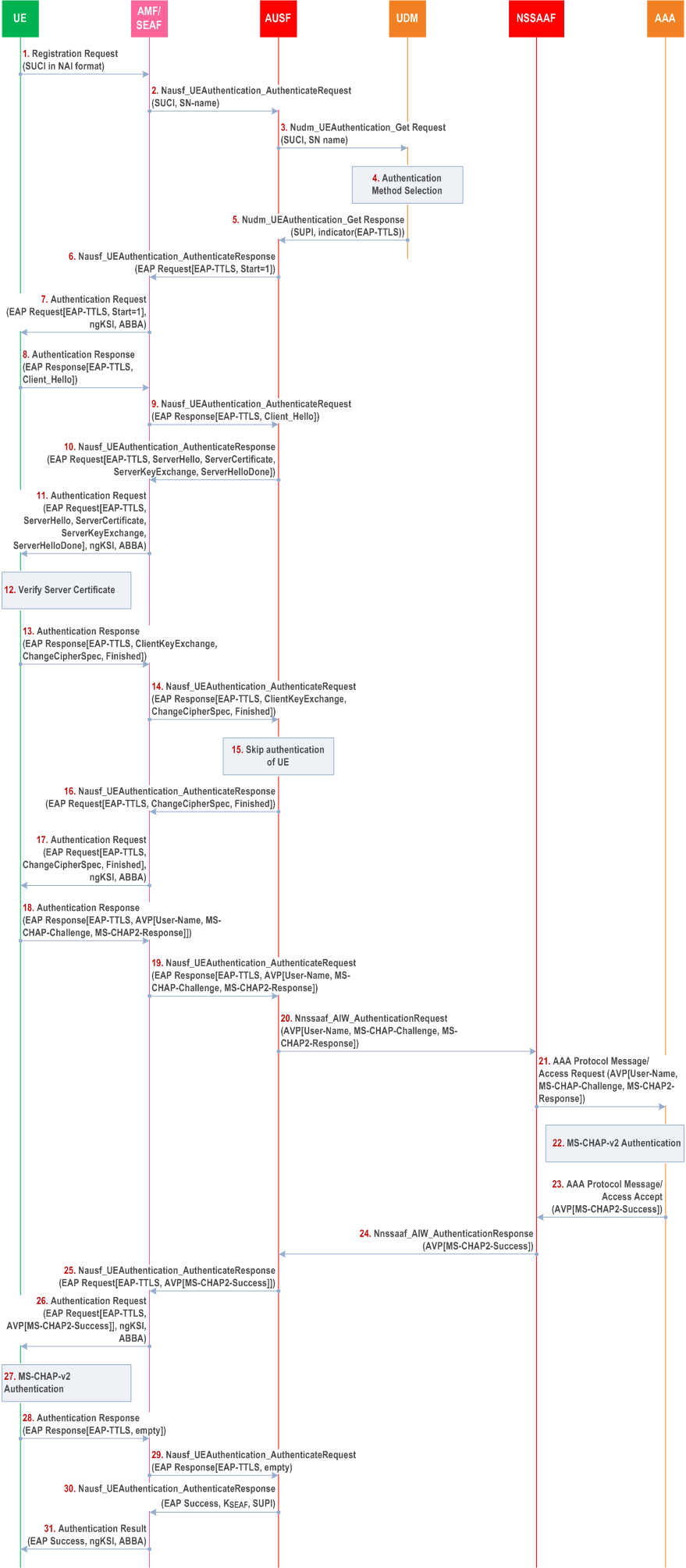Content for TS 33.501 Word version: 19.1.0
1…
4…
5…
5.3…
5.9…
5.10…
6…
6.1.3…
6.1.4…
6.2…
6.2.2…
6.3…
6.4…
6.5…
6.6…
6.7…
6.8…
6.9…
6.10…
6.11
6.12…
6.13
6.14…
6.15…
6.16…
7…
7A…
7A.2.3…
7B…
8…
9…
10…
11…
12…
13…
13.2.2…
13.2.4…
13.3…
13.4…
14…
15…
16…
A…
B…
C…
D…
E…
F…
G…
I…
I.9…
J…
K…
M…
N…
O…
P…
R
S…
T…
U…
V…
W…
X…
Y…
Z…
U Primary authentication using EAP-TTLS in SNPNs |R17| p. 299
U.1 Introduction p. 299
In SNPN, when a credential holder is located outside of the 5GC of the SNPN, EAP-TTLS can be used to authenticate the UE. EAP-TTLS consists of two phases of authentication. In the first phase, a TLS tunnel is established between the UE and the EAP-TTLS server on AUSF. In the second phase, a legacy authentication protocol can be run between the UE and the credential holder (namely AAA) through the established TLS tunnel.
After the successful completion of EAP-TTLS, the AUSF and the UE derive the KAUSF from the EMSK.
UE is provisioned with a trust anchor to enable verification of the EAP-TTLS server certificate. The provisioning of trust anchor on the UE is outside the scope of this document.
U.2 Procedure p. 299

Step 0.
Steps 1-17 are same as the steps 1-17 in clause B.2.1.1 in Annex B, except in the following steps:
The UE is configured with the trust anchor needed to authenticate the certificate of the EAP-TTLS server running on the AUSF. Further, the UE is configured with the credentials required to authenticate with the AAA server.
Step 1.
The SUPI in the NAI format, i.e., username@realm, is used.
Step 5.
EAP-TTLS is selected by the UDM as the authentication method.
Step 6-17.
EAP-TTLS phase 1 is executed between the AUSF and the UE. EAP-Type is set to EAP-TTLS and the authentication of the UE using TLS client certificate is skipped. Since TLS client certificate is not used in EAP-TTLS, the UE need not be configured with UE certificate.
Step 18-27.
After EAP-TTLS phase 1 is successfully completed, the UE runs EAP-TTLS phase 2 authentication with the AAA as specified in RFC 5281 and RFC 9427 via NSSAAF. The phase 2 authentication method used is outside the scope of the present document but MS-CHAPv2 is depicted here as an example to show that the Nnssaaf_AIW_Authentication service offered by NSSAAF carries AVPs if the phase 2 authentication method is non-EAP.
Step 28-31.
After EAP-TTLS phase 2 authentication is successfully completed, the rest of the procedures are same as steps 18-21 described in clause B.2.1.1, except that the EAP-Type is set to EAP-TTLS in the EAP Response message from the UE to the AUSF.